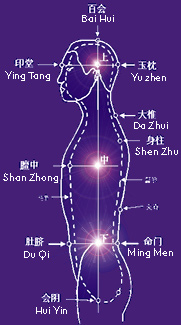
| |
| Home |
| About us |
| Private Sessions |
| Zhineng Qigong |
| Teachers |
| Benefits of Practice |
| QiField Therapy |
| Links |
| What is QiGong? |
| Nature as Last Resort |
| Qi Store - Buy Classes! |


©2006-2016 FGA
|
QiField Therapy
|
|
QiField Therapy is a psycho-energetic method that combines the Qifield Technique with SE™ to help regulate the nervous system out of shock or traumatic stress. QiField Therapy works both on the internal energies of the body and nervous system while creating a safe and harmonious environment for the blocked energy to release. The Qifield Technique also helps the therapist to glean information about the substance, energy and information concealed within a client's symptoms such that their underlying causes can be more quickly released and harmonized. SE™ is not psychotherapy or psychiatry, it is a naturalistic healing process developed by neuro-physiologist Peter Levine that relies on the functioning of the autonomous nervous system. SE™postulates that events in themselves are not traumatizing, the trauma results from the incomplete self-protective responses that remain as energy blockages in the body. At its root, SE™ works on the exact same energetic principles as Zhineng Qigong. If you have difficulty ‘letting go’ and continue to suffer after these or similar situations: - Accidents We can help you release the
undelying blockage in your nervous system
so that you can bounce back to vibrancy and
fullness. We can work with you in English or Spanish Somatic Experiencing is a form of therapy aimed at relieving and resolving the symptoms of post-traumatic stress disorder (PTSD) and other mental and physical trauma-related health problems by focusing on the client’s perceived body sensations (or somatic experiences). It was introduced by Dr. Peter Levine in 1997. He presented at length his observations of animals in the wild, and how they deal with and recover from life-threatening situations. He concludes that their behaviour gives us "an insight into the biological healing process", and that "the key to healing traumatic symptoms in humans lies in our being able to mirror the fluid adaption of wild animals" as they avoid traumatization in reacting to life-threatening situations. TheoryThe theory postulates that the symptoms of trauma are the effect of a dysregulation of the autonomic nervous system (ANS). It further postulates that the ANS has an inherent capacity to self-regulate that is undermined by trauma, and that the inherent capacity to self-regulate can be restored by the procedures of Somatic Experiencing. PracticeThe procedure, which is normally done in a face-to-face session similar to psychotherapy, involves a client tracking his or her own felt-sense experience. Practitioners of Somatic Experiencing are often also psychotherapists, Rolfers or BodyWorkers. Certified practitioners must complete a training course that spans three years. The procedure is considered by its practitioners to be effective for Shock Trauma (see below) in the short term (typically one to six sessions). It is also considered effective for Developmental Trauma as an adjunct to more conventional psychotherapy that may span years. SE™ works primarily with three phases of processing within the brain stem. The procedural execution of these steps keeps us alive and thriving in three different ways: 1.
Orientation to the here-and now
within the external environment as a felt sense
within the organism, and engaging in social
interaction (i.e. cooperation, reproduction, feeding,
etc.). Research has shown
that this system works beautifully in all animals
including humans. However, it is clear that
animals are not traumatized by these experiences
while humans are.
The mind is capable of entering into a relationship with the body through active sensation. The resulting interaction engages the primary functions of the human body: Mind, Feeling/Emotions, Physical/Somatic perception. The unifying factor in this action is INTENTION or WILL to heal. The blending of these different levels causes the whole complex to relax and open to the Qi (pure energy) surrounding us in Nature - of itself in a continuous state of harmonious balance. The Intention to heal can bring a person's mind into direct contact with a bodily feeling. This may in turn elicit the perception of an emotion. The mind's intention blends with the bodies' structure and organs, and further with the emotions that arise out of tension and relaxation. By using the mind, feeling and body together, a fourth activity is initiated that results in healing or integration: intentional blending, relaxation of concepts and barriers, and openness of the mind/feeling/body to return to its natural integrated state. "We cultivate our own life energy through accessing nature's great store of life energy (qi). This approach produces quick results. But cultivating one's qi is not the most fundamental; cultivating one's spirit is. Mastery of qi is really achieved through mastery of consciousness. We use consciousness in a careful, craftsman-like way, to shape our life, to attain our goals. If we use modern terminology to name this process, we call it qigong..." "…in modern terms, qigong is just the refinement of consciousness to enhance the state of energy in the body. This leads to vibrant health, a harmonious body and mind, and an awakened spiritual life. If you would like to arrange a personal healing facilitation, please write to qi@qifieldtherapy.com or call 415.484.9895
|
Northern California Southern California Online Encuentro - La Práctica de la Felicidad | Sábado 3 d Febrero 2018 09.00 PST 18:00 CET Vínculo para participar disponible 2 d Febrero 2018
|